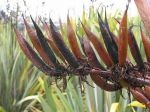Oue
| Cultivar No | 26 | |
|---|---|---|
| Source | Tairawhiti (East Coast). | |
| Description | Short, strong, straight, pale green blades with blunt Gothic points particularly on the young blades. Similar to Awahou but not such wide blades. Margin and keel are brownish orange. Few short kōrari with heavy, blunt seed pods. The Oue described in some early records and given the synonym Tāpoto corresponds to the harakeke Tāpoto in this collection. Best (1909) says that Urewera Māori distinguished two sexes of Oue: the male, with longer fibre, more pointed and reddish leaves, and harsh fibre with a reddish tinge and the female, with shorter leaves and fibre, light reddish edges and soft white fibre. Best says that Oue was brought to the Urewera from Waikato. |
|
| Uses | Very good all purpose harakeke. Some mature blades may be used for piupiu but not really a piupiu variety . Makes very strong kete which dry out well into a rich pale parchment shade when boiled for one minute. Slightly darker when unboiled. |
|
| Muka extraction | Muka extracts well, but some leaf matter sticks to fibre. Para only partially removes, rest to be scraped with knife. Medium to large amount of muka. | |
| Raranga - unboiled | Whenu are of even thickness but a bit hard to soften. Not a beginners flax. Great for raranga, not as waxy as Awahou, but in all other respects very similar. Wide leaf producing lots of rather short whenu. Good for whiri bottom kete. |





